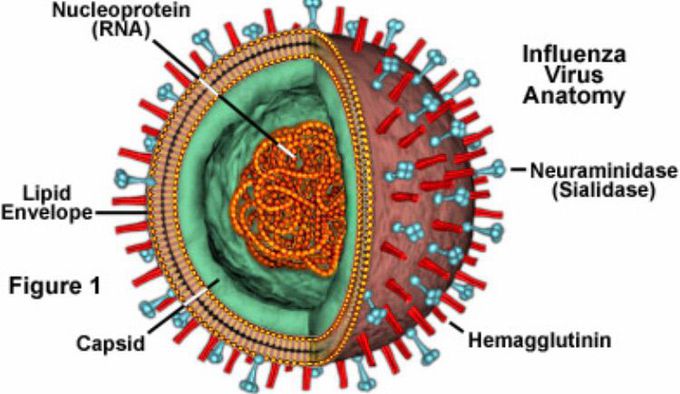


H1N1 Virus
Research- H1N1 ( Swine Flu ) The H1N1 virus, also known as the swine flu, is a type of influenza virus that is originally transmitted by infected pigs with the influenza virus. This virus can also be spread by breathing in contaminated droplets of moisture in the air. The swine flu is part of the influenza strain. H1N1 is a type A influenza virus. This means the disease is spread through mammals. In H1N1’s case, it I spread by pigs ( hence the name “swine” flu ). This images is the anatomy of an influenza virus cell. This image is closely identical the the type A influenza virus. This disease had a pandemic in April 2009 through August 2010. H1N1 killed up to 575,400 people and nearly 61 million people were infected during that short time period of nearly 1 year and 3-4 months. During this time medicine has never been so modern before. But physicians and scientists were unable to understand the difficult cause of this virus. The signs and symptoms of H1N1 are similar to normal influenza signs and symptoms. Some of the signs and symptoms of H1N1 are: - Cough - Fever - Sore throat - Stuffy or runny nose - Body aches - Chills - Fatigue To treat the unexpected respiratory symptoms And signs like cough, sour throat, and runny stuffy nose, patients can take Sudafed ( pseudoephedrine ) to loosen up mucus in bronchioles ( take this if you have a “wet cough” ) if you have a dry cough take cough drops to suppress the tickle of the throat. Smoking can also make this virus worse due to the already weakened lungs smokers have and the chronic bronchitis. H1N1 is normally spread from person to person like the normal flu. Avoid touching areas that are contaminated. Avoid droplets of moisture from someone that is suspected with H1N1 after they sneezed. Clean doorknobs regularly so the spread of this virus doesn’t spread rapidly. In the H1N1 virus humans with this virus vomit more than usual compared to the regular influenza virus. A test called “Rapid Influenza Diagnostic Test” is a rest that is used for both the flu and H1N1. To take this test your doctor will placed a swab in you nose and collect cultures of mucus in nasal canal. Your doctor will bring the swab up your nose then down you throat. Those who are at high risk from life-threatening of problems from swine flue are: - kids who are under five years of age - People who are older than 65 - People with Reyes syndrome - People who are on long term aspirin therapy - Pregnant women There is a vaccine for H1N1. It is the same as the influenza vaccination. You can treat the swine flu by taking medicine like rapivad and relenza. But oseltamivir, doesn’t respond to most patients. The overall difference between H1N1 (swine flu) and the normal influenza virus is that patients with swine flu will experience much more vomiting with this virus and more respiratory problem.
the most dreaded are the complications of the swine flu, most commonly people end up with a superadded bacterial infection due to the neuraminidase affecting ciliary movement..

